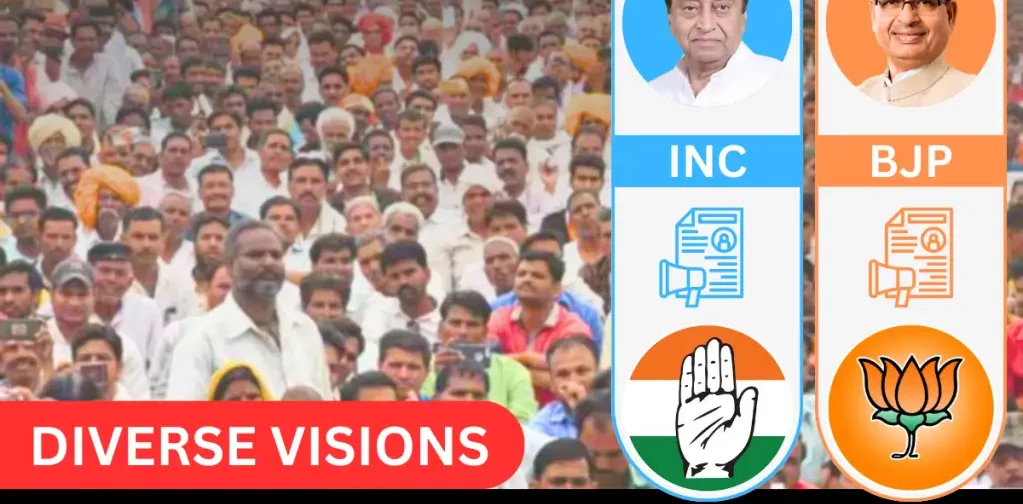
The Election Commission has scheduled the Madhya Pradesh Assembly Elections of 2023 in single-phase voting on November 17. The results, which will determine the composition of the 230-member assembly, will be declared on December 3, 2023. There are 5.6 crore voters, including 2.88 crore males, 2.72 crore females, and 22.36 lakh first-time voters.
Currently, the state is governed by the Bharatiya Janata Party. As the election draws near, it becomes crucial to explore the manifestos of different political parties to grasp their vision and commitments for shaping the future of the state. The tenure of the Madhya Pradesh Legislative Assembly will conclude in January 2024. The electoral contest primarily features the BJP and Congress.
BJP’s Manifesto:
Chief Minister Shivraj Singh Chouhan has introduced many pro-women initiatives closure to the end of the assembly’s term, including 35% reservation in government job vacancies and 50% in teaching positions for women. Schemes like ‘Ladli Bahna Yojana’ provide monthly aid of ₹1,250 to 1.32 crore women, while ‘Ladli Laxmi Yojana’ aims to enhance the health and education of girls and combat female feticide and child marriages. The government also offers subsidized LPG gas cylinders at ₹450 under the “Pradhan Mantri Ujjwala Yojana and the Mukhyamantri Ladli Bahna Yojana”, benefiting a wide range of consumers. The manifesto expresses that ‘भाजपा है तो भरोसा है, भाजपा है तो विकास है, भाजपा है तो बेहतर भविष्य है ।” 2
The Congress Party Manifesto:
The Congress party has unveiled a comprehensive 160-page manifesto in Bhopal for the upcoming Assembly elections, outlining its vision and policy priorities. They have also highlighted a range of welfare measures for farmers, women, and youth. Embracing Hindu cultural traditions, the manifesto reaffirms the commitment to cow protection and pledges a 100-crore package for constructing a Narmada pilgrimage corridor and renovating old temples.
Among the guarantees provided in the manifesto are a socio-economic caste Census, an increase in OBC reservation from 14 per cent to 27 per cent in the state, 25 lakh health and 10 lakh accident insurance for each family, Rs. 1,500/- monthly allowances for women, affordable cooking gas cylinders at Rs. 500/- each, free electricity up to 100 units and 50 per cent waiver in tariff up to 200 units, doubling social welfare pension from Rs 600/-, free school education, and Rs 1,500/- to Rs 3,000/- allowance for unemployed youth. It also promises to provide “Fasal Rakshak”, or protector of crops, bicycles, agricultural tools, and their minimum wages for crop damage, farm loan waivers up to Rs 2 lakhs.
Furthermore, Congress has also committed to purchase a quintal of wheat for no less than Rs. 2,500/- to Rs. 2,600/- for paddy, free power supply to farms, and even a rural fire brigade service to deal with farm fires and many more. 3
The Congress manifesto outlines key initiatives, such as reconstituting the NITI Aayog and Statistical Commission to create a five-year plan for the state. It proposes suggesting to the Centre that Madhya Pradesh should have a Legislative Council and establish a “manifesto implementation” sub-committee headed by a vice-chairperson under the office of CM. The manifesto of the Congress party aims to address a wide range of issues and concerns in the state and reflect its vision for the future.
Others:
The Bahujan Samaj Party (BSP) has formed an alliance with the Gondwana Gantantra Party (GGP), and their manifesto is yet to be disclosed. Typically, BSP is averse to publishing election manifestos. The Aam Aadmi Party (AAP) is also contesting with an undisclosed manifesto.
Conclusion:
Manifestos of two major parties in the state, i.e. BJP and Congress, are competitive and focused on targeting as many sections of the society as possible. Both the parties are promising welfare measures for women at large, which has brought the women’s voters to the centerstage of the electoral contest. The voters across the state have wide areas of schemes from both the parties to compare and make up their mind.
